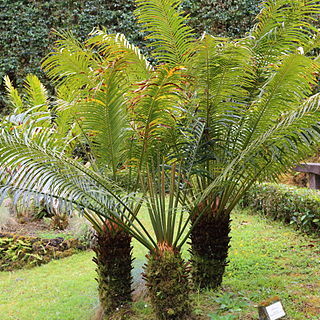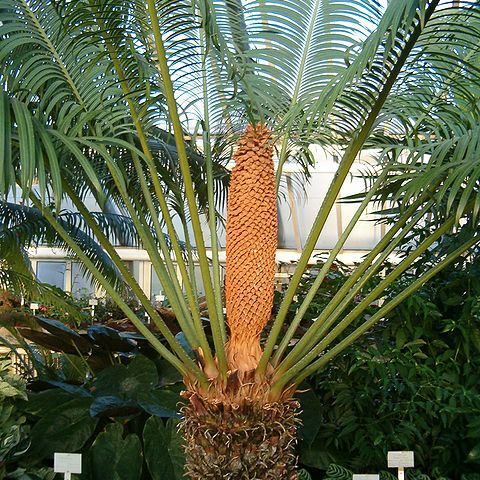Tree to 10 m tall; trunk to 40 cm diam., light grey, deeply fissured into ± rectangular pieces. Leaves 1.5–2 m long. Pinnae numerous, closely spaced, subopposite, narrow, linear, decurrent at base as a narrow wing on the rachis, finely acuminate, glabrous, coriaceous, dark green, glossy, to 25 cm long; midvein prominent; petiole 30–50 cm long, with scattered recurved spines. Male strobilus oblong-ellipsoidal, 30–60 cm long, orange, foetid. Megasporophylls c. 30 cm long, fleshy, densely brown hairy; fertile area c. 3.5 cm wide, somewhat flattened, with c. 6 marginal ovules; tip obovate, flattened, acuminate; margins weakly toothed. Seed subspherical, c. 5 cm long, glabrous, green becoming wrinkled and red-brown.
More
A palm like plant. The plant can be 3-10 m high. The trunk is not swollen at the base. The trunk is covered with the bases of the old leaves. The leaves have leathery leaflets with a distinct midrib. The leaves are something like feathers. They are 1-2 m long and have leaflets along the stalk. These leaflets are 28 cm long by 2 cm wide. A cone of thick leaves with large seeds is produced at the top. They are separately male and female plants. The seeds are 3-4 cm across with a thin fleshy covering and a starchy centre.
The pith is processed to extract the starch during times of food shortage. The seeds are sometimes eaten after treatment by slicing, fermenting for 2 weeks and then cooking. They can be used for flour. The very young unfolded leaves are cooked and eaten in Malaysia. CAUTION The young leaves are poisonous to cattle. The seeds are poisonous unless treated. They contain a toxic glucoside. They contain Hydrocyanic acid.
More
Sago can be prepared from the pith by drying, grinding and washing. The seeds are poisonous, containing the toxic glucoside pakoein, but have a high starch content. They become edible after pounding and repeated washing followed by boiling or roasting to produce a starchy meal. The seeds, bark and mucilaginous sap are widely used for poultices on sores.



